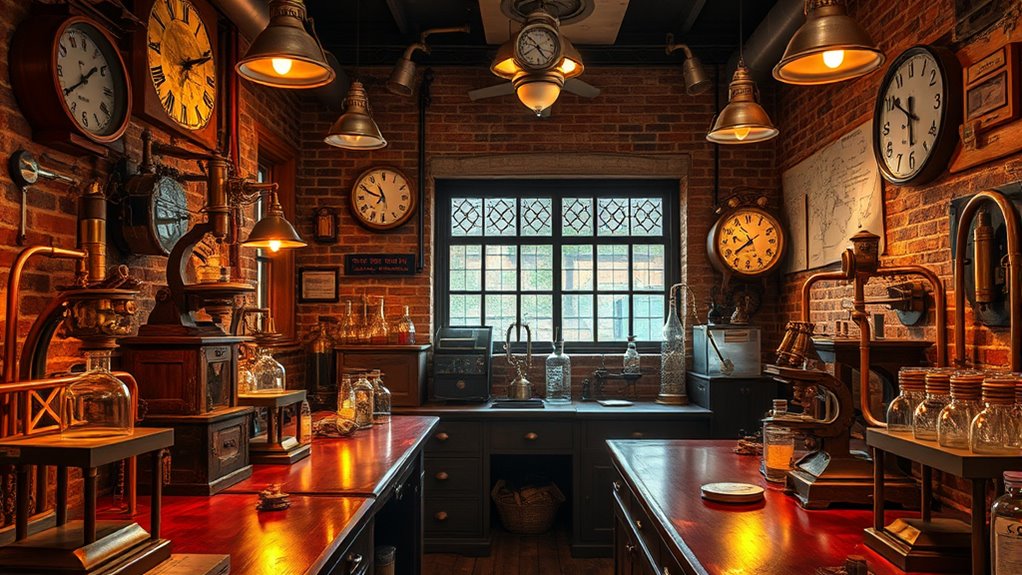Inside a steampunk lab, you’ll find Victorian-inspired gadgets that blend elegance with ingenuity. Brass telescopes with intricate engravings stand ready for celestial observation, while clockwork automata perform delicate tasks with tiny gears visible. Extendable tubes, levers, and dials showcase craftsmanship and mechanical complexity. Every tool combines beauty and function, capturing a spirit of scientific curiosity and artistic flair. Stay curious, and you’ll uncover even more fascinating gadgets and secrets tucked inside this inventive world.
Key Takeaways
- A steampunk lab features brass gadgets with intricate engravings, combining Victorian elegance and mechanical ingenuity.
- Discover clockwork automata performing tasks like pouring tea, showcasing craftsmanship and lifelike motion.
- Functional and ornamental brass telescopes with extendable tubes highlight scientific curiosity and aesthetic detail.
- Devices incorporate exposed gears, levers, and dials, emphasizing mechanical complexity and dual-purpose design.
- The environment fosters exploration, with adjustable instruments and automata that blend science, art, and inventive spirit.

Steampunk lab gadgets blend Victorian-era aesthetics with inventive machinery, creating a unique fusion of old-world charm and futuristic innovation. As you explore the workspace, your eyes are drawn to intricate clockwork automata, tiny machines that mimic human movements with precise gearwork and delicate levers. These automata aren’t just decorative; they serve as demonstrations of mechanical ingenuity, showcasing the steampunk scientist’s mastery over gears and springs. Watching a clockwork automaton perform a simple task, like pouring a miniature cup of tea or turning a page, highlights the blend of artistry and engineering that defines the genre. Their meticulously crafted mechanisms invite admiration for the craftsmanship involved, with each tiny cog and wheel carefully assembled to create smooth, lifelike motion.
Nearby, brass telescope designs dominate the workspace, their polished surfaces gleaming under warm, flickering light. These telescopes aren’t merely tools for stargazing; they’re statements of scientific curiosity and Victorian elegance. You notice how the brass components are often engraved with intricate patterns, echoing the decorative motifs of the era. The telescopes’ extendable tubes and adjustable mounts reflect a meticulous attention to detail, allowing for precise observations of the night sky. Many steampunk labs incorporate these brass telescope designs as both functional instruments and ornamental pieces, merging practical use with aesthetic appeal. As you handle or inspect one, you feel the weight of history and innovation in its solid build, imagining yourself peering into the cosmos through a device that’s as much art as science.
In this environment, gadgets like clockwork automata and brass telescope designs serve dual purposes. They are tools for exploration and experimentation, but also symbols of Victorian ingenuity and craftsmanship. These devices often feature exposed gears, levers, and dials, inviting you to appreciate the mechanical complexity that makes them work. Every piece seems to tell a story of invention, a blend of science and art that embodies the steampunk ethos. Whether you’re adjusting a telescope to catch a glimpse of distant planets or winding up a clockwork automaton to perform a task, you’re engaging with a world where timeless craftsmanship meets futuristic imagination. This fusion creates a fascinating space that feels both nostalgic and inventive, inspiring you to dream up your own mechanical marvels.
Frequently Asked Questions
How Do Steampunk Gadgets Function Without Modern Electronics?
Steampunk gadgets function through intricate clockwork mechanisms and pneumatic systems, which don’t rely on modern electronics. You wind up clockwork gears to power movements, while pneumatic systems use compressed air to operate parts or create effects. These gadgets harness mechanical energy, pressure, and timing, allowing them to perform complex tasks. So, you see, their functionality depends on clever engineering with gears, levers, and air pressure, not digital tech.
What Materials Are Typically Used in Victorian Steampunk Gadgets?
You’ll notice that Victorian steampunk gadgets often feature materials like brass and leather components. For example, a custom-made pocket watch might have a brass casing with intricate engravings, while leather straps secure its parts. These materials not only give gadgets an authentic, vintage look but also serve practical purposes. Brass provides durability and a polished finish, whereas leather adds flexibility and a touch of elegance, making each device both functional and aesthetic.
Are There Any Safety Concerns With Steampunk Scientific Devices?
You should be aware of safety hazards when handling steampunk scientific devices, as they often incorporate exposed gears, sharp edges, and potentially hazardous materials. To minimize risks, practice proper risk management by wearing protective gear, ensuring stable setups, and avoiding misuse of components. Always follow safety guidelines, and don’t underestimate the dangers of Victorian-inspired gadgets, which can be as risky as they look intriguing.
How Are Steampunk Gadgets Powered Without Electricity?
You operate steampunk gadgets using mechanical energy and chemical reactions instead of electricity. These devices often harness gears, pulleys, and clockwork mechanisms to generate power, while chemical reactions like volatile compounds or acids fuel certain gadgets. You might wind a spring to store mechanical energy or use a chemical reaction to produce gas or heat, which then powers the device. This creates a fascinating, vintage feel while maintaining functionality without modern electricity.
Can These Gadgets Be Built at Home by Enthusiasts?
Yes, you can definitely build these gadgets at home, but beware—crafting authentic-looking steampunk devices is no simple task. You’ll need to immerse yourself in DIY projects and source unique materials like brass, gears, and vintage components. The process is rewarding and sparks creativity, but it requires patience and ingenuity. If you’re ready to embrace the challenge, your lab can become a treasure trove of Victorian-inspired gadgets that tell a story of innovation and adventure.
Conclusion
As you explore these Victorian-inspired gadgets, remember that curiosity fuels discovery. Steampunk labs remind you that necessity is the mother of invention, often leading to the most ingenious gizmos. Embrace the wonder of these intricate devices, and let your imagination run wild. After all, the sky’s the limit when you dare to dream and create—just like the inventors of the Victorian era. Keep exploring, and who knows what marvels you’ll uncover next.









